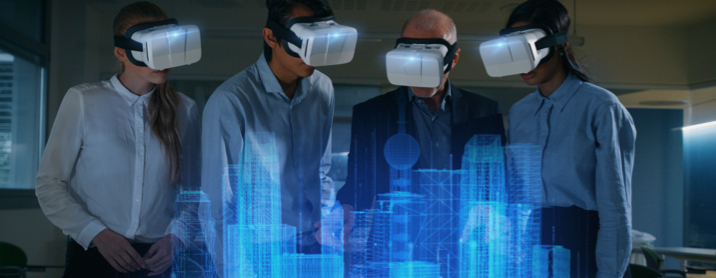INNOVATION
Why the Metaverse Matters to Businesses
INNOVATION
Why the Metaverse Matters to Businesses


The fact that businesses the world over have yet to even reach a consensus as to what the metaverse actually is (or will be), doesn’t seem to be preventing many of them from making financial investments in its future.
While it might sound like the technological equivalent of putting the cart before the horse, companies are intrigued enough by the potential of the metaverse being “the next big thing” that they’re willing to roll the dice—and bet big—on this very real, yet still very nebulous concept. For companies considering how to navigate the metaverse, knowing where to start can be a pretty overwhelming proposition. In our opinion, the best first step begins by answering the first question that most people usually pose in regards to the metaverse: what is it?

What Is a Metaverse?
What Is a Metaverse?
A metaverse is a shared, virtual, three-dimensional space (3D) where users are represented by avatars; it can also be supplemental 3D content in the real world. These spaces, which exist even when you’re not in the space, grow and evolve based on user decisions and interactions within the space. In other words, just like the real world. There’s no “end” or overarching objective to a metaverse; it’s not a virtual theme park to be explored or a game to be won. A metaverse is simply another world where you can do the kinds of things you do in the real world. One word that you’ll hear proponents of the metaverse mention quite a lot is “presence.” Not just the fact that you’ll be present in these worlds via your avatar, but that you’ll feel like you’re really there, and feel that other people are there with you.
Traits of a Metaverse:
There’s no "off" switch, they continue indefinitely
They exist in real-time
Different users can do different activities at the same time
Users can create, own, sell, and invest
Different platforms can work together in the metaverse
Users can create content that other users can enjoy
The Metaverse Means (Serious) Business
The Metaverse Means (Serious) Business
A metaverse is a shared, virtual, three-dimensional space (3D) where users are represented by avatars; it can also be supplemental 3D content in the real world. These spaces, which exist even when you’re not in the space, grow and evolve based on user decisions and interactions within the space. In other words, just like the real world. There’s no “end” or overarching objective to a metaverse; it’s not a virtual theme park to be explored or a game to be won. A metaverse is simply another world where you can do the kinds of things you do in the real world. One word that you’ll hear proponents of the metaverse mention quite a lot is “presence.” Not just the fact that you’ll be present in these worlds via your avatar, but that you’ll feel like you’re really there, and feel that other people are there with you.

Yes, It's a Lot Like Second Life
Yes, It's a Lot Like Second Life
Perhaps the best way to give you a clearer sense of what a metaverse actually is is through comparison. Back in the mid-2000s, Second Life gave users the chance to, well, live a second life in a 3D, online virtual world (another popular example is The Sims).
At the peak of its popularity, Second Life boasted 1 million regular users. These users created avatars and did the exact kinds of things they did in their real lives: they hung out, went to the movies, listened to music, attended parties, played games, etc. However, what really set Second Life apart was not just that its “residents” had the freedom to interact with each other, but that it had an in-world economy, and that is why eCommerce businesses are paying attention to the potential of the metaverse.
The Potential for eCommerce in the Metaverse
The Potential for eCommerce in the Metaverse
While the metaverse may sound like it’s geared mostly to serious gamers and tech geeks, the metaverse will become the foundation for a new digital economy, where users will be able to create, buy, and sell goods. This explains why so many retailers are rapidly trying to get their heads around the concept of a metaverse and—in some cases—already making considerable investments in developing their own metaverse. Gartner found that, by 2026, 25% of people will spend at least one hour a day in the metaverse shopping and seeking out entertainment. When you see a stat like that, it’s little wonder that retailers are so bullish on the metaverse.
How Retailers Can Benefit From the Metaverse
How Retailers Can Benefit From the Metaverse
Establish a New Revenue Stream
Today you make retail purchases one of two ways: through a website or in a physical store. With the introduction of the metaverse, retailers can not only add a third revenue stream but one that has the very real potential to surpass the previous two in sales and profitability. In a Google survey, 66% of people said that they’re interested in using augmented reality (AR) for help when shopping, and Shopify revealed that interactions with products having 3D content showed a 94% higher conversion rate than those without it. This will allow consumers to make better-informed purchasing decisions, leading to higher profit margins for brands.
Lower Return Rates
There are certain products that are traditionally difficult to buy online; those products tend to see high return rates. Showcasing those products within a virtual experience gives the buyer plenty of time to fully immersive themselves in the features, specifications, and benefits of those products, which will reduce the return rate and help build brand loyalty. The metaverse won’t be about simply duplicating your retail or online store into a virtual one. It will be about generating out-of-the-box thinking and embracing the opportunity of creating your brand experience together with your customers.
Conduct Free Market Research
Retailers could use the metaverse as a way to learn about customers’ real-life preferences. They could test products in the metaverse before going through the process, and expense, of producing a similar version in the real world. Shoppers could use the metaverse to try out products before making a purchase, just look at Decentraland’s recent Metaverse Fashion Week. The high-profile fashion event in the metaverse brought together some of the most well-known brands you’d typically see during NY Fashion Week. Those brands could potentially use the data yielded from the vent to determine which virtual versions of their designs are to become real-life versions.

Some Brands Were Early Adopters
Several well-known brands have already dipped their digital toes into the metaverse. Electronics giant Samsung created Samsung 837X, an immersive world hosted in Decentraland and modeled after the flagship Samsung store in Manhattan. As part of the experience, users can explore a new Connectivity Theater, Sustainability Forest, and Customizable Stage, where guests can attend mixed reality dance parties and other live events.
Other early use cases include Nikeland in Roblox, Gucci Garden, and Dyson Demo VR. The Dyson experience, in particular, showcases an immersive 360-degree virtual reality experience where users can test Dyson products without leaving their homes—a really practical way to combine virtual reality and a physical product. Even with just these early examples, the potential for retail in the metaverse is endless.

What About the B2B World?
What About the B2B World?
Just because retailers have been the first to make their presence felt in the metaverse doesn’t mean the metaverse only offers opportunities for consumer-facing companies. Here are some ways in which the metaverse will benefit B2B companies:
Increased Collaboration and Networking
With the growth of metaverse technology, B2B businesses can now leverage opportunities to build client relationships face-to-face via their avatars. Research in Harvard Business Review revealed that face-to-face communication is 34x more effective than any text-based exchange, which isn’t surprising, given the power of nonverbal cues in building rapport and trust between people.
More Immersive Customer Experiences
According to SuperOffice, 86% of buyers are willing to pay a premium for excellent customer service, and 49% of them have made impulse purchases after receiving a more personalized experience. In the metaverse, B2B sellers will be able to create more immersive buyer experiences, and these enhanced interactions could make for easier sales.
New Marketing and Advertising Opportunities
As the metaverse continues to expand, B2B businesses will have access to new marketing and advertising opportunities. Companies can sponsor metaverse events or create targeted ads that are more likely to attract potential customers, and because the metaverse is still in its early stages, businesses that establish a presence now will have a first-mover advantage.
Increased Sales and ROI
Ultimately, the goal of any business is to increase sales and revenue, and the metaverse provides a unique opportunity to do just that. By establishing a presence in the digital space, B2B enterprises can reach new markets and tap into new sources of revenue. The metaverse also has the potential to increase sales productivity. For example, a B2B salesperson can host multiple meetings with buyers from different parts of the world, all without having to leave their metaverse office.
Improved Employee Productivity
It’s not just sales that can benefit from the metaverse. Departments like human resources, customer service, and research & development can also use this technology to increase productivity. With metaverse-based training simulations, employees can learn new skills faster, and customer service agents can use avatars to provide assistance in real-time. This technology also has the potential to improve communication and collaboration between employees. Remote workers can now meet face-to-face in the virtual space to discuss projects, share ideas, and provide feedback.

How Can You Get Started?
How Can You Get Started?
While you might not quite be ready to jump in with both feet to the metaverse, there are some things you can do to at least start preparing yourself for it:
Think About Your Target Audience
How much time do your target audiences/customers spend in the metaverse? You can use the answer to that question to plot out the speed of your immersion into the metaverse. Obviously, brands focusing on younger demographics probably don’t want to sit on the sidelines for too long. What behaviors are trending with your current and prospective consumers right now? They’ll give you an indication of how fast to move into the metaverse.
Watch Your Competition
Start paying attention to what companies like yours are starting to do in the metaverse. While “watch what your competitors are doing” isn’t a revolutionary tactic, it’s an effective one. The whole metaverse proposition can be very daunting, both in terms of understanding it and in trying to figure out next steps. Watching the actions of your competitors will not only help let you know when you need to start taking concrete steps to participate in the metaverse, but it’ll also help put you in an “if they can do it, so can we” mindset.
Find Balance
Anything new, and the metaverse certainly qualifies, has both inherent risks and rewards. The metaverse may be very unpredictable and lacking in standards but, the good news is that the pandemic made us all way more agile than ever before. Will there be metaverse experiments that bomb? Yep. Second Life offered the promise of the metaverse years ago and did not take hold. Fortunately, the negative effects for brands that participated were not significant or long-term.
Get Creative
If the metaverse is a blank canvas then you need to start thinking about how to unleash your creativity and your storytelling. With a bigger creative palette, you can create experiences at any point in the customer journey, from acquisition to customer support and anywhere in between; experiences that have the potential to be both amazing and super sticky.
Improved Employee Productivity
It’s not just sales that can benefit from the metaverse. Departments like human resources, customer service, and research & development can also use this technology to increase productivity. With metaverse-based training simulations, employees can learn new skills faster, and customer service agents can use avatars to provide assistance in real-time. This technology also has the potential to improve communication and collaboration between employees. Remote workers can now meet face-to-face in the virtual space to discuss projects, share ideas, and provide feedback.
The Opportunity Is Real
The Opportunity Is Real
Some people think that the metaverse is a futuristic concept that won’t happen for quite some time. In terms of the ultimate vision for the metaverse, yes, it’ll probably be 10 years or so before we see something even close to what futurists are envisioning. However, there are bonafide opportunities today for brands to take advantage of these early days of the metaverse, opportunities that they can use to not only become a metaverse pioneer but establish an early brand presence.
Brands that hesitate to take those first, formative steps, or worse, that fail to see the incredible potential of the multiverse, risk missing out on something that, by all accounts, is, in fact, going to be the next big thing. In other words, if you snooze, you lose, both, in the virtual world, and, in the real one.
Learn more about PeakActivity’s Innovation service offerings to see if they’re right for you.
Want even more educational content?
Subscribe below to get timely content delivered to your inbox,
or fill out the form below to speak to a Peakster about your next project.

DIGITAL MARKETING
Top 10 Photos of Developers Staring At Screens

DIGITAL STRATEGY
5 Ways Retailers Can Make Influencer Marketing More Influential

ECOMMERCE

